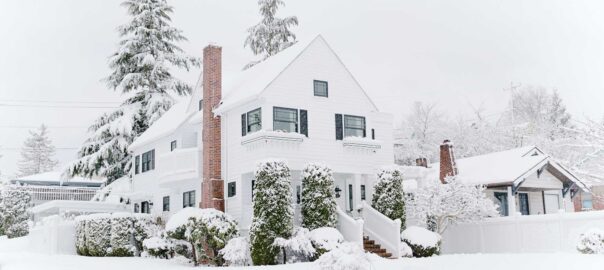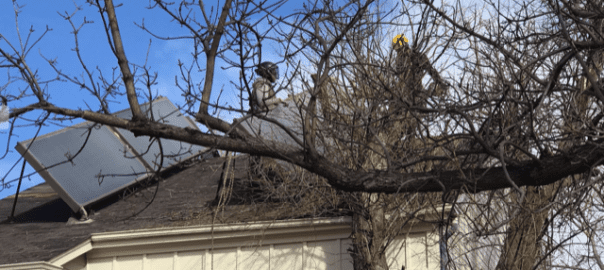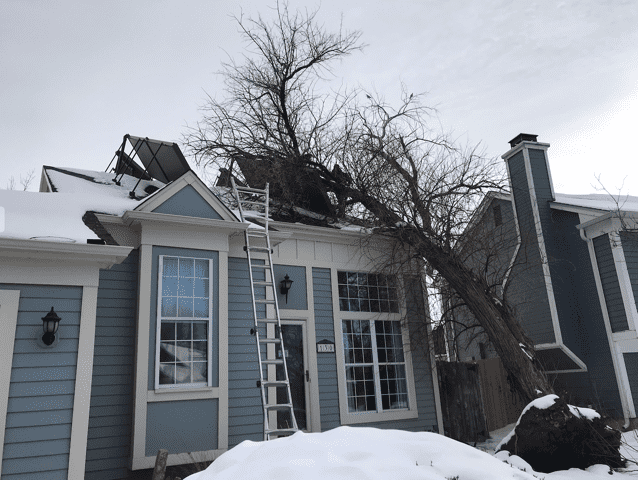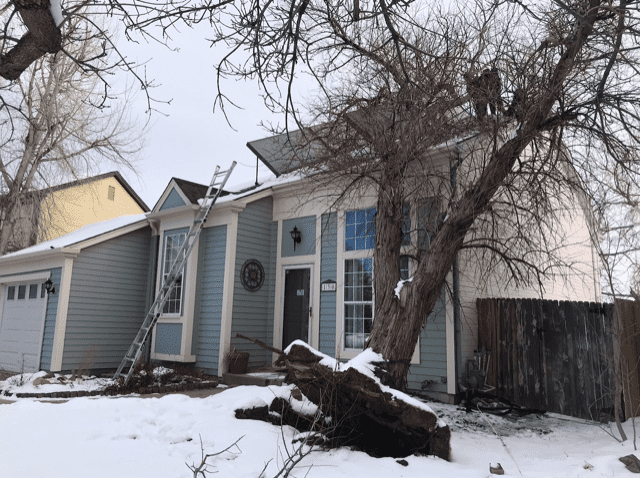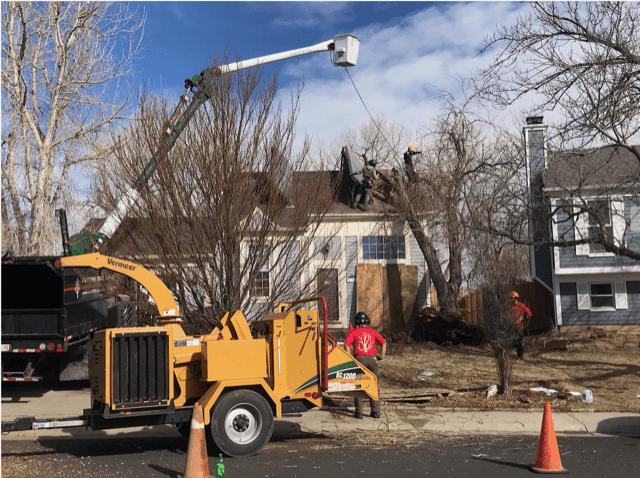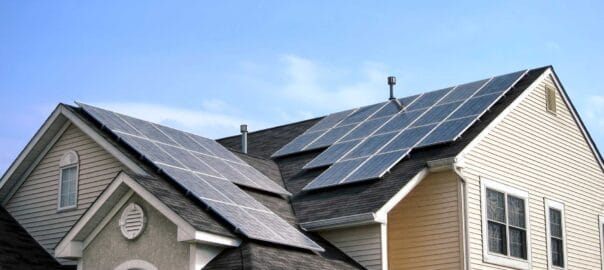As a homeowner, one of your main responsibilities is to take steps to prevent roof leaks. Without regular maintenance and preventative measures, your roof can start leaking as it ages, and that can lead to costly repairs or even replacement. Fortunately, there are several simple steps you can take to prevent roof leaks from occurring in the first place!
Understanding Roof Leaks
Before we dive into preventative measures, it’s important to understand how roof leaks happen.
Typically, roof leaks occur when water seeps in through damaged shingles or flashing – the metal strips that prevent water from entering at the edges of a roof and around vents, chimneys, and other protrusions. When these protective barriers fail, water can penetrate the roof and cause extensive damage.
In some cases, damaged shingles or flashing may be the result of extreme weather events, such as windstorms, hail storms, ice and even tornados. These can put enormous strain on a roof’s structure and can cause holes or ruptures that allow water to get in.
Sometimes preventative steps – such as regular maintenance and inspection – can prevent roof leaks from happening in the first place. Making sure that your roof is free of debris, that shingles and flashing are intact, and that your attic has proper ventilation can all go a long way towards keeping your roof in good condition.
It’s also important to be aware of age and wear-and-tear. Over time, a roof’s materials may break down and need to be replaced in order to prevent water damage. If you’re unsure of the age or condition of your roof, it’s best to contact a professional roofing contractor for advice and professional opinion.
Signs That Your Roof May Be Leaking
One of the best ways to prevent roof leaks is to be on the lookout for signs that your roof may be leaking. Here are a few things to look out for:
- Discoloration or staining on interior walls or ceilings
- Mold, mildew, and odor in the attic
- Blistering paint on the exterior wall
- Peeling wallpaper
- Water spots or water trails inside the home
- Puddling or dripping during of after a storm
If you notice any of these signs or suspected roof damage, contact a professional roofer to inspect your roof and take the necessary steps to prevent further damage.
Essential Steps for Preventing Roof Leaks
Taking preventative steps to protect your roof is a must, and here are a few of the best ways you can prevent leaks on your own:
Make sure all shingles are in good condition and that no loose or cracked shingles are present.
As a homeowner, checking the condition of your roof shingles is essential to ensuring the safety and structural integrity of your home. Although you may not want to climb up on your own roof, checking for loose or cracked shingles regularly is an important part of maintaining your roof’s health.
Here are some steps you can take to inspect your roof shingles and identify any that may need to be replaced:
- Examine the area near the chimney, vents, and edges of your roof for any cracked or missing shingles. These areas are especially exposed to the elements, so checking them often is important.
- Look at the valleys of your roof, checking for any cracked or loose shingles. Valleys are the intersections where two roof surfaces meet, and if they’re compromised your home may be at risk of water or ice damage.
- Examine the nails used to secure each shingle in place. Look for any that have pulled away from their original position, as this could be an indication that the shingle has been damaged. High winds can and do pull up loose shingles. They can also cause what are called “nail-pops” where the head of the nail protrudes up under the shingle and it pokes through the shingle causing a hole and possible water intrusion point.
- Take a look at your roof from the ground using binoculars or a telescope. This is an easy way to spot any missing or cracked shingles without actually getting on the roof.
These steps should help you identify any potential problems with your roof shingles. If you have any concerns about the condition of your roof, it’s always best to contact a professional for an inspection. They can help you make sure that your home is safe and secure.
Inspect for any missing nails or metal flashing.
Inspect the nails used to secure shingles and inspect for exposed nail heads or any missing nails. Look for any signs of rust on the metal flashing, which could indicate corrosion. Check that all nails are properly sealed with silicone, mastic or a proper sealant to prevent water from entering the roof decking through the nail holes. Inspect your roof’s joints and seams for any gaps or separations. Pay special attention to the areas around vents and exhausts, as these are common spots for water intrusion.
To inspect for missing nails or metal flashing:
- Start at the edge of your roof and work your way up in a zig-zag pattern.
- As you inspect, look for any loose shingles or gaps between shingles that could indicate missing nails.
- Check for any visible nail heads and inspect the metal flashing to look for any signs of rust, corrosion or damage.
- Look in the corners of where the different roof slopes meet. There can be specialized flashing at these points that can come loose and cause issues if it pulls away from its original location.
If you notice any issues, such as missing nails or metal flashing, contact a roofing professional to inspect the roof and make any necessary repairs. This will help ensure your roof remains in optimal condition and can help prevent costly water damage.
Regularly clear the roof and gutters of debris and leaves, which can cause water pooling.
Clearing your roof of debris, such as leaves and twigs, and even bird droppings is important to keeping it in top condition. In addition to being an eyesore, debris collecting on your roof can lead to water pooling which can cause problems for your home’s structure over time.
Water pooling occurs when the rain or melting snow has nowhere to go because of the debris on your roof. This can create long-term water damage as the water collects and pools, potentially leading to issues such as rot, mold, and other structural damage. Bird droppings are acidic and can eat into the shingle if left over time.
Fortunately, clearing your roof of debris is relatively simple if done correctly.
Here are a few steps you can take to ensure that your roof is free from any debris and water pooling:
- Inspect your roof regularly for any signs of debris accumulation. This should be done at least once or twice a year, but more frequently if you live in an area with frequent storms or your home is surrounded by trees.
- Remove any visible debris by using a leaf blower, rake or broom to clear it away. Be sure to wear protective gear, such as gloves and a dust mask, if needed.
- A lot of people Install gutter guards or leaf-catching systems on your gutters. These can help prevent leaves and other debris from clogging your gutters and causing water pooling on your roof. And they are also prone to ice damming in the winter and can cause large icicles to form on the gutters also with ice dams that can damage the roof. To be honest, we don’t recommend them.
- Have a professional regularly inspect your roof for any signs of water pooling or other damage.
By taking these steps, you can help keep your roof clear of debris and protect it from water pooling. If you ever spot any signs of water pooling or damaged shingles on your roof, contact a professional immediately to address the issue before it worsens. Taking care of your roof now can save you a lot of time and money in the long run.
Replace any damaged gutters and downspouts that prevent water from entering your home.
Replacing damaged gutters and downspouts is a necessary step for homeowners to take in order to prevent water from entering their home through the roof. It’s important for homeowners to understand the process of replacing damaged gutters and downspouts, as well as the steps needed to complete this task.
The industry norm for gutters is “seamless gutters” which are rolled out and created on site so that there are no seams to leak other than the corner joints. This is done by a professional. The gutters that you would pick up at a home improvement store are not sufficient to use on any property that you value. They just don’t hold up very well.
Here are the steps that we go through for new gutters:
- First, we measure the length of your gutter or downspout and purchase the appropriate materials needed to replace the damaged area. There are choices of the thickness of the metal and also the actual size of the gutters. The common size is a 5” gutter. They also have 6” gutters if the roof is large and needs more flow to handle a lot of water coming off your roof.
- The gutters are then mounted properly with “gutter hangers” to the fascia of the home.
- We also make sure that the gutters are angled properly so that they will drain appropriately. You may see them slightly sloping toward the downspout to ensure proper drainage.
- We also put an adhesive sealant to ensure that the joints and end caps will be securely fastened in place and be without leaks.
- We then use snips and drills to put the holes in them for the downspouts so that they are accurately placed.
- Finally, we make sure all of your connections from the gutters to the downspouts are sealed and fastened properly in order to prevent water leakage.
Replacing damaged gutters and downspouts may seem like a daunting task, but with the right knowledge and materials, it is an easy process that can save homeowners from costly repairs in the future.
Check for signs of discoloration or staining on the exterior of your roof.
One of the key steps a homeowner should take to ensure their roof is in good condition and preventing roof leaks is to look for signs of discoloration or staining on the exterior. Knowing what to look out for can help you identify any potential problems before they become too serious.
The process of checking for signs of discoloration or staining is fairly straightforward:
- The first step is to determine where you should check. You should focus on areas around the roof that are exposed to direct sunlight and places where water could collect, such as the valleys between shingles or the area near the eaves and gutters.
- After determining the locations of your inspection, then you can begin to look for signs of discoloration or staining. These signs can appear as dark spots, streaks, patches, and/or fading on the roof’s exterior surface.
- If your roof has any of these signs, then you should contact a professional roofer to assess the damage and make any necessary repairs.
At the end of the day, checking for signs of discoloration or staining on your roof is an essential part of keeping it in good condition. By following these steps and inspecting your roof regularly, you can ensure that any problems are identified quickly and taken care of promptly before they become too serious. This will help keep your home safe, secure, and properly protected from outside elements.
When it comes to preventing and repairing roof leaks, hiring a professional roofing company is always the best choice.
With their expertise and experience, they can identify any potential problems before they become bigger issues. Furthermore, they have the right tools and materials to ensure that the repair is done properly and within safety regulations. This ensures that your home remains protected from the elements and keeps your roof functioning optimally.
Another benefit of hiring a professional roofing company is that they can help you save money in the long run. By preventing or repairing minor roof leaks, you can avoid costly repairs down the line. This not only saves you money but also prevents future damage to your home and property.
Additionally, a professional roofing company can provide advice on preventing future problems and help you maintain your current roof in top shape.
Your roof is an integral part of your home, so it’s essential to take preventative measures to prevent roof leaks from occurring. By following the steps above and being vigilant about regular maintenance, you can prevent roof leaks and protect your home from costly repairs in the future.
If you do find signs of a leak, contact a professional roofer as soon as possible to prevent further damage. And remember, prevention is key – so make sure you take the steps outlined above to prevent roof leaks for good!




